Russian chronicle historiography of the "Ice Battle"
In our country, books about the Battle of the Ice, including those with interesting illustrations, in particular, drawings by I. Dzysya, were published many times. But in this case, it makes sense to show illustrations by the English artist Angus McBride for the book Medieval Russian Armies 1250 -1500 V. Shpakovsky & D. Nicolle / Oxford, Osprey, 2002. This is to the fact that we like to reproach Western authors in some belittles of our history. But look at these illustrations, from which English students have been studying this period of our military history for 14 years. And where do you see Russians in dirty sheepskins and onuchs with stakes in their hands? Meanwhile, not a single drawing in Osprey's editions can be placed without detailed proof of every detail cited and reference to artifacts. It's easier to write the book itself than to find it all! Here, too, you see a heavily armed horseman of 1250 from Western Russia (left), a horseman of southeastern Russia (center) and a Pskov boyar (right). Of course, 1250 is not 1242, but the difference is small!
However, it is easier for us now. We take only one event and look at how it was reflected in the texts of our chronicles. Yes, they have many discrepancies, but they were written by living people. On the other hand, it is clear that the no closer the text is to the time of the event, the more reliable it should be, for it can be based on “the testimony of Samovidy”. In any case, it will be interesting to everyone to get acquainted with these texts in full. At least, it is not necessary to climb on numerous volumes (and there are a lot of them!) And look out there for scary chronicle lines. But at the same time it is possible to compare how much, who and how quotes them!
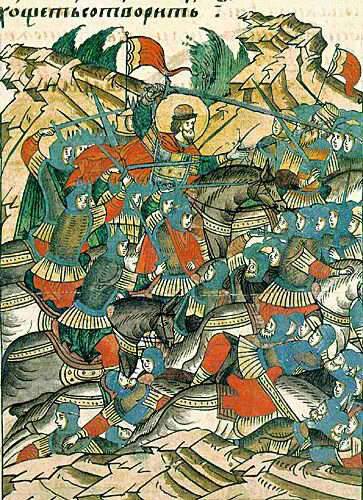
Miniature from the "Life of Alexander Nevsky", included in the Facial Chronicles (XVI century). Neva battle.
So let's start by pointing out that, quoting a description of the famous Battle of Peipsi Lake, most historians preferred to refer to the 1 of the Novgorod Chronicle. This is the most detailed and compact work, but, apart from this text, they also quote vivid excerpts from the 1 of the Sofia Chronicle, the Resurrection, Simeonovskaya and a number of other chronicle texts, as well as the Life of Alexander Nevsky, which complement the battle description with vivid details. And, of course, it should be noted that many historians have used these sources uncritically, while others have thought the material altogether.
For example, historian A.I. Kozachenko wrote: “We have heard the tale“ About the great Prince Alexander ”. The author of this tale was a contemporary of Alexander, knew him and witnessed his exploits, was “a Samovidian of his age.” And further ... "The chronicler, according to an eyewitness, writes:" And there was evil and great Nmtsem and Chyudi, and trusk from the mines of breaking and the sound of scattering, as the sea would freeze. And I don’t see ice: weight to blood "".
But all these stories are just a literary conjecture of a certain monk from the Nativity monastery in Vladimir, and were written already in the 80-s of the XIII century. Well, the Life of Alexander Nevsky (and not a legend at all!) Was written in the literary style of the traditional description of the battles of that time, but not on the testimonies of eyewitnesses. Because if we believe the author of the Life, it turns out that this "samovidets" not only could hear the speeches of the soldiers of Alexander and his prayer, ascended by him on the battlefield, but also ... really see "the regiment of God on the vezdus" that came to the rescue prince, that is, we then need to recognize the authenticity of "miracles".
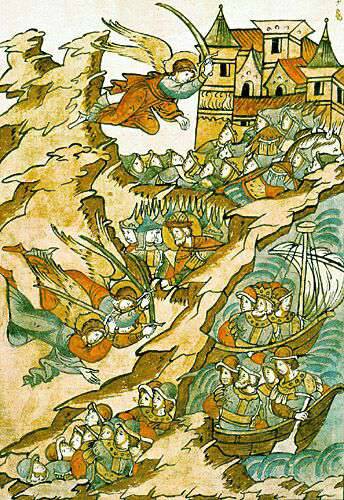
Miniature from the "Life of Alexander Nevsky", included in the Facial Chronicles (XVI century). Neva battle. The army of Alexander Nevsky crushes the Swedes, and the angels help him!
Famous historian, academician M.N. Tikhomirov, who studied this text, notes that the author compares Prince Alexander with the historical characters he knows: that he was handsome, like Joseph the Beautiful, was equal to Samson by force, but in bravery he was comparable to the emperor Vespasian, who ravaged Jerusalem, and His voice was "like a trumpet among the people." From here, some historians very naively portrayed Alexander as a man of enormous height, with a voice like a trumpet. And humanly, this is understandable, but this is only literature, not history.
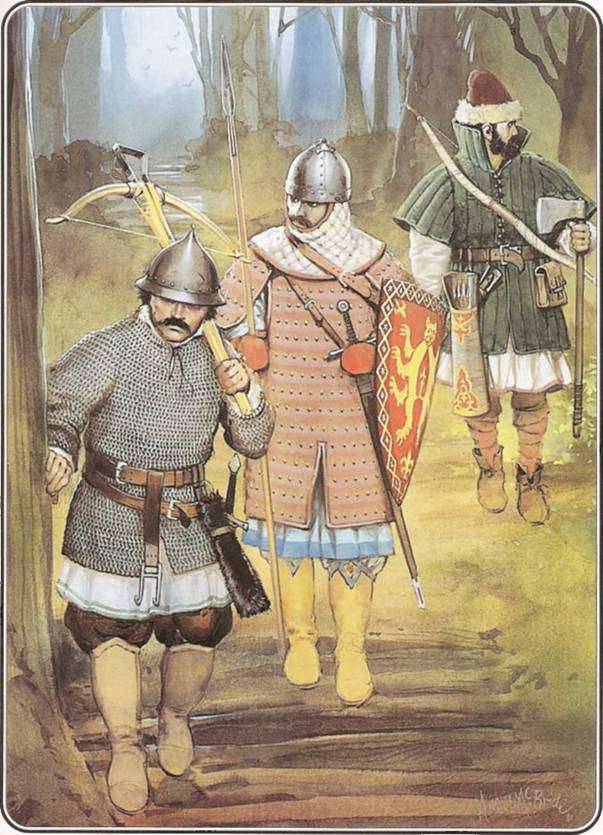
Russian "Pawn" 1250 - 1325 On the left is a crossbowman, in the center is the militia of the city militia, on the right is an archer.
Soviet-era historian V.T. Pashuto wrote: “It was not possible for crusader robbers to“ reproach the Slovenian language below themselves ”,” and refers to the Novgorod chronicle of the younger edition of 1. But ... does not indicate that these words are taken not from the text of the chronicle, but again from the text of The Life of Alexander Nevsky. Soviet military historian LA Strokov writes: “Our chronicler reports:“ They are proud, copulating and deciding: Come on, we will defeat Grand Duke Alexander and have it with our hands ”, and also refers to the 1 texts of the Sofia Chronicle, but does not indicate that these words taken again, not from the suicide text, but again from the Life of Alexander Nevsky, and does not notice that in the 1 of the Sofia Chronicle they are transmitted with distortion: instead of “the other city,” they are “pride”. So, over the years, there was an inaccuracy of the “car and small truck” and they grew like a snowball.
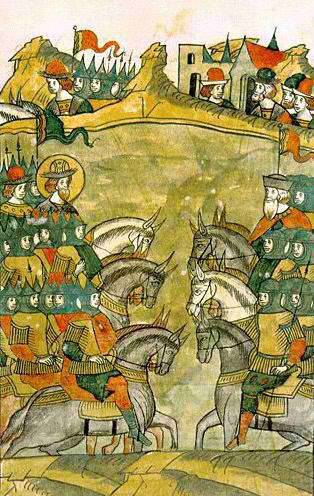
Miniature from the "Life of Alexander Nevsky", included in the Facial Chronicles (XVI century). Prince Alexander opposes the Germans, but the battle has not yet begun!
The historian Ye.A. Razin. “Judging by the chronicle miniatures, the battle formation was turned to the steep bank of the lake behind the rear, and Alexander’s best squad took refuge in one of the flanks.” At the same time, he seemed to rely on miniatures of the Laptev volume of the Facial Chronicle, which dates back to the third quarter of the 16th century. But these miniatures cannot be judged on the construction of troops, nor on the presence of an ambush regiment, since the medieval miniatures themselves are very conditional, and they have their own “book life”. Thus, the text of the Nikon chronicle under a miniature, written in p. 937 rev. It sounds like this: “And, having become strong by the power of the cross, make obedience to go on them, advancing Lake Chyudskoe. There is also a plurality of velmi. His father, the Grand Duke Yaroslav Vsevolodich, sent him to help his brother, Menchago Prince Andrea, with his many soldiers. Taco bo byashe from the great ... ".
And what do we see in miniature? In the upper right corner of Prince Yaroslav, which sends Prince Andrew with the army to help Prince Alexander, in the upper left corner - Prince Andrew and his soldiers, and in the center is the battle itself. And there is not, on a miniature, no ambush regiment. In any case, we do not see.
Here we see the riders 1375 - 1425's. On the left - an equestrian drummer of the end of the 14th century, in the center - an equestrian spearman of the beginning of the 15th century. with the Lithuanian shield-pavez, prince of the end of the 15th century As you can see, judging by the iconographic images and artifacts that have come down to us, our knights in no way inferior to the knighthood of the West!
Many historians refer to the texts of the 1 of Novgorod, 1 of the Pskov, Voskresensk, Lviv and Nikon chronicles, but do not figure out how their texts relate to each other and the text of “Life ...”. Meanwhile, all written sources of the XIII century. about the Battle of the Ice should be divided into several source groups: I - written in Novgorod, which are reflected in the 1 of the Novgorod Chronicle of the senior edition; II - Pskov, reflected in the Suzdal Chronicle; III - Rostov; IV - Suzdal, reflected in the Laurentian Chronicle; V - early Vladimir, - "The Life of Alexander Nevsky" in the first edition. The sixth group is, respectively, the late Vladimir news from the “Vladimir chronicler” of the 16th century. All the first groups belonging to the 13th century arose independently of one another, and the event described one thing - the battle known to us at the beginning of April 1242.
And this is her description from the 1 of the Novgorod Chronicle of the senior.
“In the summer of 6750. Go Prince Oleksandr from Novgorod and his brother Andrey, and from Nizovtsi to Chudsky land on Nemtsi and to Zaya, and to Plskov. And expel Prince Plskov, expel Nemtsy and Chud, and, having shackled, flow to Novgorod, and go to Chud himself. And as if by land, let go of everything in prosperity, and Domash Tverdislavich and Kerbeta would be in the razgone, and I would waste Nemtsn and Chyud at the bridge, and that one. And ubisha that Domash, the brother of the breeder, the husband is honest, and with his hands, with his hands, and with his hands to the prince, in the regiment. The prince will sleep on the lake, Nemtsy and Chyud go on them. Prince Oleksandr and Novgorodtsp saw, put a regiment on Chudsky lake, on Uzmen, at Voronya kameni. And nahasha on the regiment Nemtsy and Chud, and run through the pig through the regiment. And there was a great slaughter of German and Chudi. God and saint Sophia and the holy martyr Boris and Gleb, for the sake of Novgorod, shed their blood, the saints with the help of great prayers to the god Alexander, for the sake of Novgorod. And Nemtsu that padosha, and Chyud Dasha splashing; and, gonyache, bisha ikh on 7-mi across the ice to Subolichskogo shore. And pada Chyudi veshchnsla, and German 400, and 50 by hand, Yasha and Nrnvedosha in Novgorod. And bishasya month of April in 5, in memory of the holy martyr Claudius, to the praise of the holy Mother of God, and Sabota. " That is, the very first chronicle gives us the number of fallen Germans in 400 people. That this Novgorod text is undoubted. It contains a link to the help of St. Sofia and St. Boris and Gleb. In the Pskov chronicles refer to the help of St.. Trinity.
From the Pskov Chronicles one can learn the following: in 1242, Prince Alexander first liberated the city of Pskov from the Germans, then fought with the German knights on the ice with an army of Novgorod and Pskov; defeated them and led the captured knights to Pskov "barefoot"; in Pskov there was a great joy about it; and Prince Alexander turned to the Pskov with a reproach, urged them not to forget what they had done for Pskov, and in the future always with particular attention to take the princes of his kind in his city!
It is not excluded that a local legend was known to the Pskov chronicler about some kind of speech with which Prince Alexander addressed the Pskov people after the battle. But we do not know its exact content. The chronicler did not know him either, and he had to resort to his own fantasy. And he urges Pskovs to be grateful to Prince Alexander and kindly accept the princes of his family. But this is again the second half of the 13th century. and, therefore, the earliest texts that we have at this particular time, and all the rest are later!
The Rostov chronicle evidence of the battle on Lake Peipsi from the Academic List of the Suzdal Chronicle is very succinct: “In the summer of 6750. Hody Aleksandr Yaroslavich from Novogorodtsy to Nemtsy and fight with them on Lake Chudsky, near Voronn kamenn, and defeat Aleksaidr and drive along the ice 7 versts, fly them. ”
An interesting story about the Ice Battle, which is in the Laurentian Chronicle, which was compiled by monk Lawrence in 1377. “In the summer of 6750. The Grand Prince Yaroslav of his son’s ambassador Andrea to Novgorod the Great, to help Oleksandrovi on Nemtsi, and I will be victorious over Pleskovoy on the lake, and full of plenty, and come back to Andrew to my father with honor. ”
Historian M.N. Tikhomirov writes that this is a Suzdal version of the battle on Lake Peipsi. There is not a word about Novgorod, the main character Alexander, but at the same time the entire honor of victory is attributed to Prince Andrey, although the Novgorod chronicles are silent about him.
The story about the Battle of the Ice is also reflected in the "Life of Alexander Nevsky" of the first edition, compiled at the Nativity monastery in Vladimir in the 80-s of the XIII century. a contemporary of the prince, a monk of the Nativity monastery in the city of Vladimir. The beginning of the text does not tell anything new. The interesting thing is this: “And Prince Olsander returns with a glorious victory. And I have a lot of people polished in his regiment, and I barefoot beside copies, I call myself God's rhetoric. ” That is, the captive knights went barefoot, but the figures, how many were there, are not given.
Thus, if we subtract from the most ancient texts all the “divine” and “miraculous”, as well as instructive and “local”, then we get the following amount of reliable information:
1. There was a campaign of Prince Alexander in the third year after the Battle of the Neva, namely in the winter - 1242; at the same time, Pskov was liberated from the Germans, and hostilities were transferred to enemy territory.
2. There was a military alliance against Rus', and that its troops opposed the Russians together;
3. The enemy was seen by the Russian guards, and the reconnaissance of the army of Prince Alexander was defeated by the Germans;
4. Prince Alexander retreated, as a result of which the Germans, one way or another, ended up near Lake Peipus, and, given the text of the Livonian Rhymed Chronicle, that the dead fell into the grass (what kind of grass could there be in April?), That is, there was in view of the dry reeds that have been preserved along the edge of the lake since summer, the battle itself was both on the shore and on the ice. Or it started on the ice, continued on the shore and on the ice, and ended with the flight of the Germans.
5. Prince Yaroslav assisted Prince Alexander by sending him his son, Prince Andrei, along with his retinue;
6. The battle took place on Saturday morning, at sunrise;
7. The battle ended with the victory of the Russian weapons, with the winners also pursuing the fleeing enemy;
8. Many enemy soldiers were taken prisoner;
9. The victors led the captured knights barefoot near their horses, that is, according to the canons of knightly honor, they disgraced them;
10. The people of Pskov solemnly received Prince Alexander in Pskov.
Now we turn to the annals of the Novgorod-Sofia set of 30-ies of the XV century. and, in particular, the 1 of the Novgorod annals of the younger edition (second edition of the Life of Alexander Nevsky). The second edition of the Life of Alexander Nevsky exists in three documents: in the 1 of the Novgorod Chronicle of the Younger Edition (first appearance), in the 1 of the Sofia Chronicle (second view) and in the Likhachev collection of the late 15th century. (third view). Here is the text from the Novgorod 1 Chronicle of the Younger Edition on the Commission list:
“In the summer of 6750. Go Prince Alexander from Novgorod and his brother Andrew and from Nizovtsi on Chyudskoe land on Nemtsi, in winter, in strength velntsu, do not boast, rkushche: "Repentance Slovenian language below myself." Already bo byashe Pskov taken, and tiyune them planted. And Prince Alexander is the way to Pleskov. And expel prince Pskov, and izim Nemtsy and Chud, and, having shackled, flow to Novgorod, and go on Chud himself. And as if by land, let go of everything in life, and Domash Tverdislavich and Kerbeta would be in the wrench. And ubisha that Domash, the brother of the husband, the husband is honest, and others with him, and some of them izimasha, and the frost to the prince went to the regiment. The prince will sleep on the lake, Nemtsy and Chud go on neh. Behold, Prince Alexander and Novgorod, stand on the Lake Chudsky, on Uzmen, at Voronya Kameni. And the Lake Chyudskoe will come, there are a lot of byashe both of them. Byashe bo u Oleksandr prince many brave, supposedly more ancient than Davyd, Caesar's stronghold, fortress. The same men of Alexandrovi were filled with the spirit of warrior, and bahu bo hearts of them aka lvom, and rykosha: "O prince, our honest and dreadful! Nowadays, lay down your heads for your time." Prince Alexander, at the entrance to the sky, and speaking: "Judge, O God, and judge my pry from the tongue of Verechna. Laughing, O Lord, as old as Moses on Amalek and my great-grandfather Yaroslav on Okannaya Spyatopolk."
Then the Sabbath is a Sabbath day, with the coming sun, and the hottest of the Nemtia and Chud regiment, and a pig through the regiment. And it was a great German and Ciuda, rubbing from copies of lamination and sound from a sword section, and I and the sea would be frozen moving.
And do not see the ice: it covered all the blood. He heard the same from the samovidts, and the speeches, like a videh of the half of God and in the air, who came to the aid of Alexandrov. And I conquer by the help of God and St. Sophia and the Holy Martyr Boris and Gleb, who for the sake of blood shed it. And Nemtsi that padosha, and Chyud Dasha plesyas and, chasing, beat on the 7 verst on the ice to the Sobolic coast. And pade Chyudi Beschisla, and German 500, and other 50 by Yasha and brought to Novgorod. A bisya april in 5, on the namyat of the holy martyr Theodul, on the praise of the holy Mother of God, on Saturday. Here, glorify the God of Alexander before all the regiments, as Jesus of Navgin at Erihon. They recly: "I have Alexandra with my hands," and these will give him a god in his hand. And having never been opposed to him in battle.
In the meantime, Alexander won a glorious victory, more than a few in his regiment, and knight beside them, a horse, I call God’s divider.
Yako is approaching Prince Alexander to the town of Pskov, and many of his people are shaking him up, and the abbess and priest in vestments are also worn by crosses and at the mercy of the prince Alexander to my gentlemen: from foreign language by the hand of Alexandrov. "
On the non-glaution of the Pskovitsi But if you forget it before the great-grandchild of Alexandrov, become like the Jew, their Lord is their prepita in the wilderness of the livers. And these are all the forgiving of their god, izvedshago from the work of Egypt.
And beginning to hear the name of Alexandrov in all countries, and to the sea of Khupozhsky, and to the mountains of Aravitsky, and the smell of the country of the sea of the Varangian, and to Rome itself. "
Here we see changes: the number of Germans killed “500” instead of the early number “400”, and “in memory of the holy martyr Claudius” - “in memory of the holy martyr Theodoul”. Then in the XV century. in the Novgorod 4 and 5 th annals, in the chronicle of Avraamka, the Rogozhskiy chronicler and in its full form in the Sofia chronicle a number of new details appeared: “50 of the deliberate governor ... and other water of the flood, taken prisoner, but wickedly ransomed” . Then, in the 1 of the Sofia annals, instead of “in memory of the holy martyr Theodoul” they were restored “in memory of the holy martyr Claudius” - they figured it out!
1-Sophiyskaya also says that the German “beast” (obviously, the grandmaster of the Livonian Order) “with all the bishops (bishops, of course) with his many and many languages,” went against Prince Alexander, “with the help of the queen,” but what it was the king, as well as the source of this news, unknown.
And here the warriors of Western Russia and Lithuania of the XV century. Left - Lithuanian infantry of the end of the XV century. To the right is the Novgorod boyar of the middle of the 15th century. In the center is a heavily armed (“knightly armed” - knightly armed - such an English term for “no knights” by social status) rider of the early 15th century, that is, the era of the Grunwald battle of 1410 of the year!
Thus, the study of quite numerous chronicle sources that have come down to us allows us to draw a number of conclusions. First: in the earliest there is no mention of the drowning of knights in the lake. Second, the number of those killed gradually rose from 400 to 500, but the number of prisoners remained unchanged. Third: initially it was not said about the significance and glory of the battle and the prince, but then it appeared in the annals, which, by the way, is not surprising, since “the big is seen in the distance”. Further, many historians still confuse the chronicle texts themselves and the text of "Life ..." —that is, they refer to a literary source as to the text of a chronicle. And although the texts of the published volumes of the Complete Russian Chronicles are available today, some authors continue to refer to the rewritten texts of school textbooks, in which "knights clad in armor" are still drowning in ice, although not a single chronicle text of the 13th century confirms this.
An appeal to the texts of the chronicles shows that in 1234, Prince Yaroslav Vsevolodovich undertook a campaign against the Knights of the Sword. There was a battle on the river Omovzhe (or Embaha). And that was there: “Ida Prince Yaroslav on Nemtsy near Yuriev, and a hundred did not reach the city ... Prince Yaroslav bisha them ... on the cross on the Omizhe Nemtsy broken, depleted them a lot” (PSRL, IV, 30, 178). That is, it is there, on the River Omovzhe, the knights went out on the ice, fell through and drowned! Probably, it was an impressive sight, otherwise the message about this would not have fallen into the annals! The chronicler mentions that "the best Numtsov nѣcoliko and nizovets (that is, the soldiers from the Vladimir-Suzdal principality, too) are nѣcolico" - that is, they and others, including "the best Germans", drowned. According to the chronicles, “Worship Nциmtsi to the prince, Yaroslav, taking with them the world to all his truth”. In 1336, the battle of Saul was fought, in which Zemgals and Samgeits fought against the Swordsmen, and with them a detachment of two hundred Pskov and Novgorod warriors. In it, the Crusaders suffered a cruel defeat, and not only the Grand Master of the Order Volkvin von Naumburg died in the battle, but also the 48 knights of the Sword Order, many of the Order's allies, but also almost all (180 of 200) warriors who came from Pskov. By the way, these data are very indicative precisely in terms of the number of those who fought. This order itself after this defeat was forced to merge with Teutonic next year, that is, its forces were undermined by this battle very seriously.
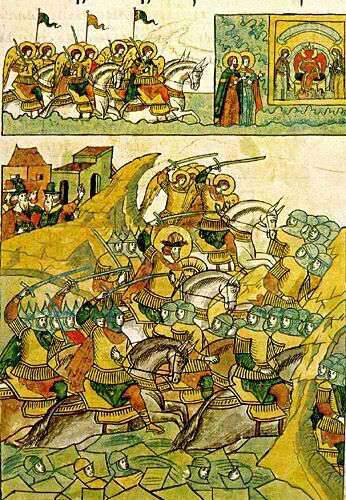
Miniature from the "Life of Alexander Nevsky", included in the Facial Chronicles (XVI century). The flight of the Germans. The vision of the heavenly host.
So there were many battles on the border of orders of knights and Russia. But, of course, the image of Prince Alexander, reflected both by many chronicles and the artistic “Life…”, acquired an epic form and a corresponding reflection in history already in our days. And, of course, it should be noted that serious historiographic and historical issues should be discussed, first of all, by professional historians who know the subject of discussion not by cheap pictures from the “Book of Future Commanders” and school textbooks for the fourth class, but by primary sources and serious research by various authors over many years.
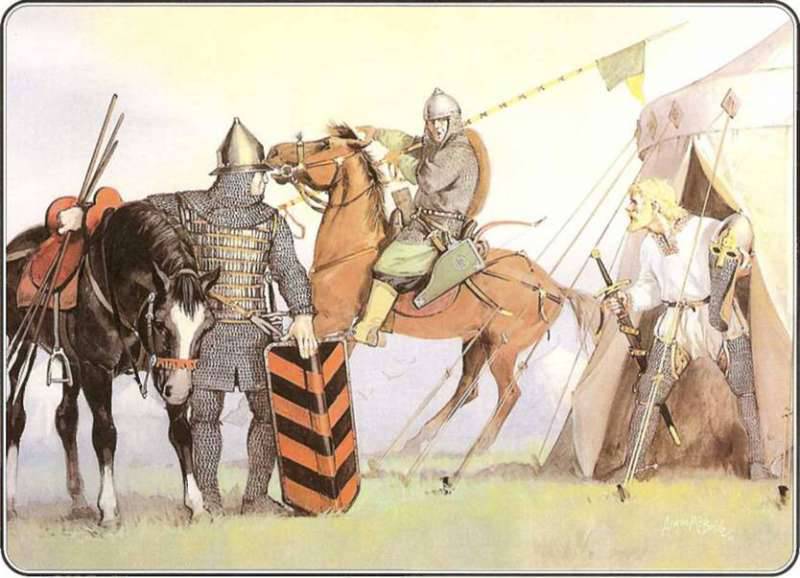
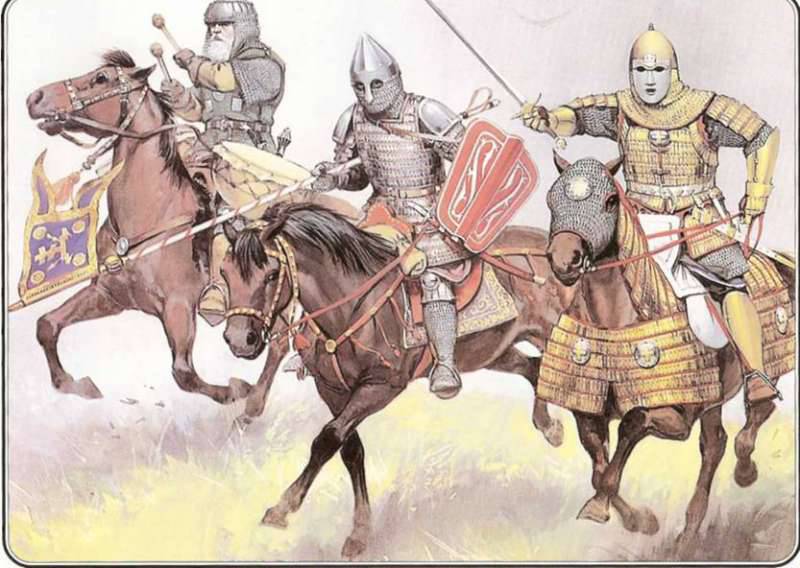
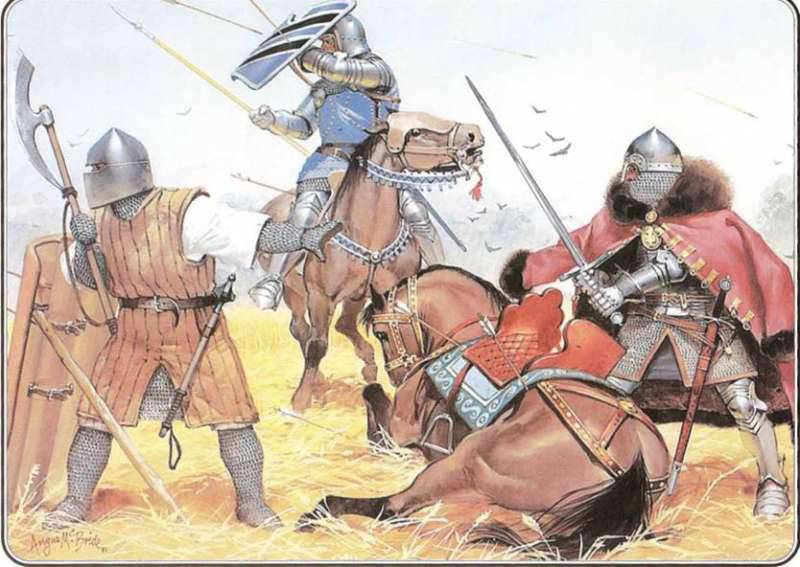
Information